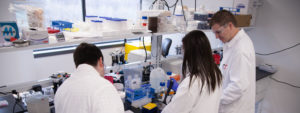March 2018 – Journal of Drugs in Dermatology
Abstract: Keratosis pilaris (KP) is a common skin finding that presents as follicular hyperkeratotic papules on the proximal extremities in patients with a propensity for atopy. Although often asymptomatic, the stippled appearance is cosmetically disturbing to patients and difficult to treat as current therapies are limited in availability and efficacy. Nitric oxide (NO) has been found to be essential in basic systemic and cutaneous physiologic function, specifically in terms of its anti-microbial and anti-inflammatory properties, which evolutionarily was maintained by ammonia-oxidizing bacteria (AOB). As modern hygiene practices have improved, there has been a gradual loss of cutaneous AOB and, therefore, the availability of an important source of human physiologic NO. We propose that restoring this dermal microflora with a purified strain of AOB, Nitrosomonas eutropha (D23), may reduce the overall cutaneous inflammatory state and, thus, be a potential therapeutic option for improving the cosmetic appearance of a skin condition such as KP which is often found in association with xerosis and atopic dermatitis. Clinical trial registry number: NCT03243617
November 2014 – Journal of the Nitric Oxide Society
Abstract: Diabetic foot ulcers (DFUs) are among the most common and serious complications of diabetes. They present in approximately 15% of diabetic patients, leading to ~ 80,000 amputations per year in the United States alone. Effective strategies for the treatment of DFUs are currently limited, thus highlighting an urgent unmet medical need. Topical delivery of nitric oxide (NO) at the wound site via NO-generating compounds, or by using acidified nitrite as a NO source, have been shown to promote healing in murine models of diabetes by reversing dysregulated expression of inflammatory cytokines, growth factors and matrix metalloproteinases among others. In the present study, we have evaluated the use of ammonia-oxidizing bacteria (AOB) of the genus Nitrosomonasas natural self-regulating biological delivery systems of NO/NOx in vivo. Nitrosomonasare ubiquitous Gram-negative obligate chemolithoautotrophic bacteria that exclusively oxidize ammonia as an energy source to generate nitrite and NOxspecies. As proof-of-concept, we proceeded to examine the capacity of a novelN. eutrophastrain to accelerate wound closure in diabetic db/dbmice. This strain,designated D23,was initially isolated from organic soil, then extensively characterized for nitrite generation and propagated in continuous culture for increased biomass yields. For testing in the db/dbmodel, three groups of eight mice each were treated daily for one week with D23 suspensions supplemented with ammonium chloride, or with vehicle control suspension only. Subsequently, full-size wounds generated on the back of each animal were treated topically once daily for 14 days with bacterial suspension or vehicle alone. Of the three AOB-treated groups, the group receiving the highest D23 doses showed significant improvement in wound closure from day 5 to day 15, with the most pronounced improvement of 83% observed on day 9 post-wounding. Based on these findings, we are exploring the potential therapeutic benefit(s) of AOB to DFUs, chronic wounds and other related indications.
